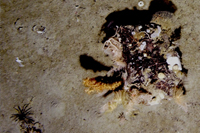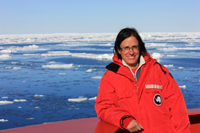News
Exploring Antarctica's marine biodiversity hotspots
Published:27 June 2014
Exploring Antarctica's marine biodiversity hotspots
Over the past summer, a team of scientists from the United States and Australia travelled to Antarctica to discover the secrets of the unexplored regions near the Totten Glacier in Australia's Antarctic Territory.
Many parts of the Earth's oceans remain unexplored. This is particularly true for the oceans off the Antarctic margin where thick ice cover, climate extremes and remoteness make exploration even more challenging.
Dr Alix Post, a marine geoscientist from Geoscience Australia, was privileged to be part of the international team invited to travel on this voyage on the icebreaking research ship Nathaniel B. Palmer funded by the U.S. National Science Foundation.
Alix's role on this interdisciplinary voyage was to characterise the seafloor habitats and biological communities from images collected from a towed camera system. These images provide the first ever glimpses of life on this remote Antarctic shelf.

Boulders on the seafloor become
covered by a diverse range
of organisms.
"During the survey we witnessed a significant phytoplankton bloom, which blanketed the seafloor in thick drifts of diatoms that had recently rained down from the surface waters," Dr Post explained.
"The mobile fauna that we observed were quick to take advantage of the food bonanza with abundant tracks across the seafloor showing the feeding patterns of animals including urchins, holothurians and sea stars," she added.
Boulders that have been deposited by melting icebergs provide a hard substrate on which a wide range of animals, such as various species of gorgonians, bryozoans and sponges can live. These "dropstones" produce localised hotspots of biodiversity, in an otherwise sparse environment.
The Totten Glacier region has recently been proposed as a Marine Protected Area in recognition of its unique and pristine biophysical characteristics. These first images of the seafloor are invaluable for understanding more about the seafloor communities and for supporting Australia's proposal to protect this area, currently under consideration by the Commission for the Conservation of Antarctic Marine Living Resources (CCAMLR).
Contact:
Phone:
Email:





